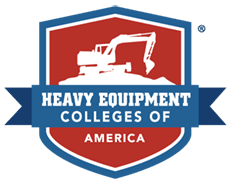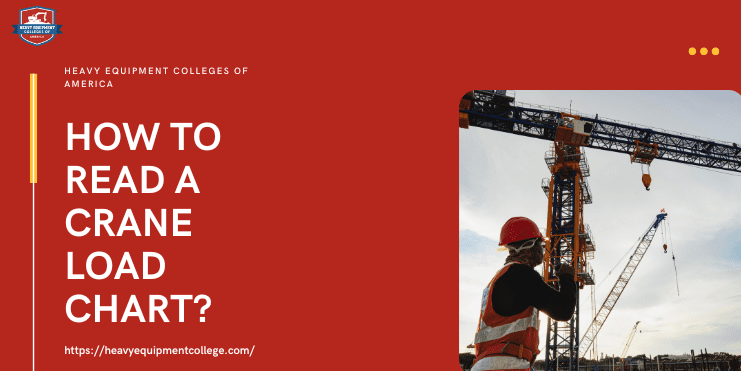A crane load chart is one of the most important tools a crane operator can have. It outlines exactly how much weight a crane can safely lift, which is determined by multiple factors.
Even though today’s cranes are often equipped with digital load indicators and safety systems, understanding how to read a crane load chart is still a fundamental skill. It helps operators make informed decisions, avoid overloads, and plan lifts safely and efficiently.
At Heavy Equipment Colleges of America (HEC), we’ve trained future heavy equipment operators on the value of a proper crane load chart. In this guide, we’ll walk through how to read a crane load chart and why they’re essential for anyone pursuing a career in crane operation.
Table of Contents
What Is a Crane Load Chart?
A crane load chart is a standardized diagram or table provided by the crane manufacturer that outlines the equipment’s lifting capacity under various configurations. It accounts for critical factors such as boom length, lift radius, counterweight position, and the crane’s configuration.
Every crane model has a unique load chart. These charts allow operators and job planners to determine the maximum weight that can be safely lifted under specific conditions, helping prevent overloading, tipping, and structural failure.
Key information typically found on a crane load chart includes:
- Maximum lift capacities by boom length and angle
- Radius of the lift (distance from crane center to load)
- Boom extension limits
- Counterweight and configuration settings
- Load deductions for equipment attachments
Why Is It Important To Know How To Read a Crane Load Chart?
Crane load charts are critical to safety and compliance. Knowing how to read a crane load chart accurately ensures that lifts are within the equipment’s capacity, reducing the risk of tipping, structural stress, or dropped loads.
Professionals who understand how to interpret these charts are more effective in their roles and better prepared for certification exams like those required by NCCCO (National Commission for the Certification of Crane Operators).
In industries such as oil and gas, shipping, manufacturing, and civil engineering, crane load charts are daily tools, not just paperwork.
Ready to Operate Heavy Equipment?
Get Certified with HEC Today!
Accelerated Programs | Multiple Locations | Job Placement Help
Open The Door To A New Career!
Start Enrollment ProcessFind The Right Location For YouHow to Read a Crane Load Chart?
Learning how to read a crane load chart starts with breaking down the different variables that affect capacity. These include the lift’s weight, distance, boom configuration, and movement. Below is a step-by-step overview of each component typically found in a load chart.
1. Lift Capacity
Lift capacity is the maximum weight a crane can lift at a specific radius and boom length. This figure changes based on how far the load is from the crane’s center of rotation.
The lift capacity of a crane isn’t a fixed number. Rather, it varies based on the radius of the lift. As the load moves farther from the crane’s center of rotation, the maximum weight the crane can safely lift decreases. This is why manufacturers provide detailed tables showing capacity limits at various boom lengths and lift radii.
Elements like counterweights, outriggers, and boom extensions directly affect the crane’s lifting ability. Before any lift, it’s essential to confirm that your setup matches the specifications listed on the load chart to ensure both safety and compliance.
2. Lift Range
Lift range refers to the horizontal distance (radius) between the crane’s center and the load. It helps determine how far out the crane can reach while lifting a specific load weight.
As the lift range increases, the crane’s lifting capacity decreases. Load charts reflect this by showing capacity limits at specific radius intervals, often every 5 or 10 feet. This allows operators to pinpoint the safe weight limits for a given reach.
3. Boom Angle
The boom angle is the angle between the crane’s boom and the ground. It directly influences the height and reach of a lift.
A higher boom angle allows for more vertical lifting, which is useful for elevating loads straight up, but it also limits how far the crane can reach horizontally. In contrast, lower boom angles extend the crane’s reach but significantly reduce its lifting capacity.
Load charts account for these variations by providing a range of boom angles and their corresponding maximum load limits at specific radii. Understanding how angle impacts both reach and capacity is essential for planning a safe and effective lift.
4. Crane Movement
Whether a crane is stationary or moving affects its rated capacity. Most cranes are designed to lift loads in a static position only. Moving with a load, referred to as “pick and carry,” dramatically lowers capacity and increases risk.
When a crane is used in stationary mode, the standard lift capacities listed on the load chart apply. However, if the crane is operated in pick-and-carry mode, its lifting capacity is often significantly reduced or even restricted altogether.
Even small movements while lifting can shift the load’s center of gravity, risking crane imbalance. In every case, operators must refer to the load chart to verify any movement-related capacity limits.
5. Deduction
Not all of a crane’s listed capacity can be used for lifting. You must subtract the weight of any lifting accessories, rigging, hooks, or jibs to determine the net lifting capacity. This process is called deduction.
For example, if a crane’s max capacity is 12,000 lbs. at a given radius but the hook block and rigging weigh 800 lbs., the net safe lifting capacity is 11,200 lbs.
Load charts often include a section listing standard deduction values for attachments. Some cranes include deduction diagrams showing how each configuration changes the net lifting ability.
How To Determine Your Crane’s Lifting Capacity and Read Load Charts?
Knowing the correct process for reading a load chart protects you and other workers on the site from load drops and critical equipment failures.
Here are some basic steps to learn how to read a crane load chart:
- Identify Your Lift Radius: Measure the horizontal distance from the crane’s center to the load.
- Choose Your Boom Length: Refer to the crane’s configuration and maximum allowable extensions.
- Determine Your Boom Angle: Use the angle indicator or calculate based on your lift path.
- Match to the Load Chart: Find the intersection of boom length, radius, and angle to see the rated capacity.
- Deduct Rigging Weight: Subtract the weight of all attachments and gear to find the net lift capacity.
- Check for Movement Restrictions: Confirm whether the lift can remain stationary or if movement is permitted.
What Is the Bold Line on the Crane Load Chart?
On most crane load charts, a bold line or shaded area separates operational zones from prohibited or unstable configurations. This line helps operators quickly identify safe zones versus no-lift zones.
It also represents the “tipping point,” beyond which the crane is no longer structurally or mechanically stable. Loads beyond this line typically fall outside the crane’s lifting range or stability limits.
How Load Charts Support Crane Safety ?
Every year, accidents occur due to misread or ignored charts, often resulting in equipment damage or operator injury. Crane safety starts with accurate load planning, and load charts help make this happen by:
- Avoiding Overloading: Operators can ensure the load is well within capacity based on radius, boom angle, and equipment setup.
- Protecting Structural Components: Staying within chart parameters prevents long-term stress or failure in boom sections and outriggers.
- Improving Jobsite Planning: Clear lift expectations help ground crews and signal persons prepare for safe, coordinated lifts.
Best Practices for Using Crane Capacity Charts
- Always use the correct chart for your crane model. Never assume different models have interchangeable specs.
- Verify that the configuration matches the chart. Check whether outriggers are deployed, counterweights installed, and boom extensions added.
- Account for all deductions. Rigging, hooks, and blocks must be subtracted from the listed lift capacity.
- Measure radius and angle carefully. Small errors can result in dangerously inaccurate lifting data.
- Avoid relying on memory. Even experienced operators should reference the chart on every job.
- Factor in environmental conditions. Wind, slope, and ground stability can affect capacity even if chart specs are met.
- Stay below capacity when possible. Never operate at the absolute limit of the crane’s capacity range.
Get Crane Operator Training at HEC
Understanding how to read a crane load chart is just one part of becoming a safe and skilled heavy equipment operator. At Heavy Equipment Colleges of America (HEC), students receive hands-on training in real-world environments, preparing them for NCCCO certification exams.
With the right crane operation certifications from an accredited school, you can start or advance your career in industries such as energy, manufacturing, infrastructure, and logistics.
Our training programs offer a structured path to becoming a certified operator for a variety of heavy equipment, including:
These programs emphasize not just equipment skills, but also critical thinking, situational awareness, and technical knowledge, all foundational qualities for a safe and effective career in crane operation.
Learn more about our programs and discover why so many students choose us for their professional development. Ready to take the next step towards a career as a heavy equipment operator? Apply online and find the program that’s right for you.
Ready to Operate Heavy Equipment?
Get Certified with HEC Today!
Accelerated Programs | Multiple Locations | Job Placement Help
Open The Door To A New Career!
Start Enrollment ProcessFind The Right Location For You
